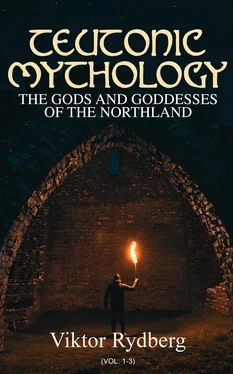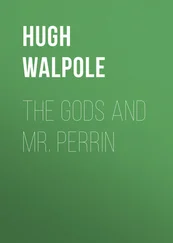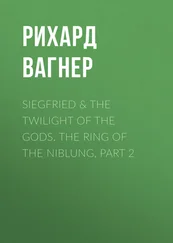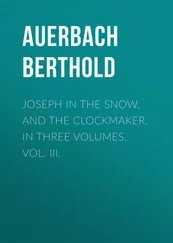In the account of Rig's visit to the three different homes lies the mythic idea of a common fatherhood, an idea which must not be left out of sight when human heroes are described as sons of gods in the mythological and heroic sagas. They are sons of the gods and, at the same time, from a genealogical standpoint, men. Their pedigree, starting with Ask and Embla, is not interrupted by the intervention of the visiting god, nor is there developed by this intervention a half-divine, half-human middle class or bastard clan. The Teutonic patriarch Mannus is, according to Tacitus, the son of a god and the grandson of the goddess Earth. Nevertheless he is, as his name indicates, in the full physical sense of the word, a man, and besides his divine father he has had a human father. They are the descendants of Ask and Embla, men of all classes and conditions, whom Völuspa's skald gathered around the seeress when she was to present to them a view of the world's development and commanded silence with the formula: "Give ear, all ye divine races, great and small, sons of Heimdal." The idea of a common fatherhood we find again in the question of Fadir's grandson, as we shall show below. Through him the families of chiefs get the right of precedence before both the other classes. Thor becomes their progenitor. While all classes trace their descent from Heimdal, the nobility trace theirs also from Thor, and through him from Odin.
Heimdal-Rig's and Fadir's son, begotten with Módir , inherits in Rigsthula the name of the divine co-father, and is called Rig Jarl. Jarl's son, Kon, gets the same name after he has given proof of his knowledge in the runes introduced among the children of men by Heimdal, and has even shown himself superior to his father in this respect. This view that the younger generation surpasses the older points to the idea of a progress in culture among men, during a time when they live in peace and happiness protected by Heimdal's fostering care and sceptre, but must not be construed into the theory of a continued progress based on the law and nature of things, a theory alike strange to the Teutons and to the other peoples of antiquity. Heimdal-Rig's reign must be regarded as the happy ancient age, of which nearly all mythologies have dreamed. Already in the next age following, that is, that of the second patriarch, we read of men of violence who visit the peaceful, and under the third patriarch begins the "knife-age, and axe-age with cloven shields," which continues through history and receives its most terrible development before Ragnarok.
The more common mythical names of the persons appearing in Rigsthula are not mentioned in the song, not even Heimdal's. In strophe 48, the last of the fragment, we find for the first time words which have the character of names— Danr and Danpr . A crow sings from the tree to Jarl's son, the grandson of Heimdal, Kon, saying that peaceful amusement ( kyrra fugla ) does not become him longer, but that he should rather mount his steed and fight against men; and the crow seeks to awaken his ambition or jealousy by saying that "Dan and Danp, skilled in navigating ships and wielding swords, have more precious halls and a better freehold than you." The circumstance that these names are mentioned makes it possible, as shall be shown below, to establish in a more satisfactory manner the connection between Rigsthula and other accounts which are found in fragments concerning the Teutonic patriarch period.
The oldest history of man did not among the Teutons begin with a paradisian condition. Some time has elapsed between the creation of Ask and Embla, and Heimdal's coming among men. As culture begins with Heimdal, a condition of barbarism must have preceded his arrival. At all events the first generations after Ask and Embla have been looked upon as lacking fire; consequently they have been without the art of the smith, without metal implements, and without knowledge of agriculture. Hence it is that the Vana-child comes across the western sea with fire, with implements, and with the sheaf of grain. But the barbarous condition may have been attended with innocence and goodness of heart. The manner in which the strange child was received by the inhabitants of Scandia's coast, and the tenderness with which it was cared for ( diligenti animo , says Ethelwerd) seem to indicate this.
When Scef-Heimdal had performed his mission, and when the beautiful boat in which he came had disappeared beyond the western horizon, then the second mythic patriarch-age begins.
22.
HEIMDAL'S SON BORGAR-SKJOLD, THE SECOND PATRIARCH.
Table of Contents
Ynglingasaga, ch. 20, contains a passage which is clearly connected with Rigsthula or with some kindred source. The passage mentions three persons who appear in Rigsthula, viz., Rig, Danp, and Dan, and it is there stated that the ruler who first possessed the kingly title in Svithiod was the son of a chief, whose name was Judge ( Dómarr ), and Judge was married to Drott ( Drótt ), the daughter of Danp.
That Domar and his royal son, the latter with the epithet Dyggvi , "the worthy," "the noble," were afterwards woven into the royal pedigree in Ynglingasaga, is a matter which we cannot at present consider. Vigfusson ( Corpus Poet. Bor. ) has already shown the mythic symbolism and unhistorical character of this royal pedigree's Visburr , the priest, son of a god; of Dómaldr-Dómvaldr , the legislator; of Dómarr , the judge; and of Dyggvi , the first king. These are not historical Upsala kings, but personified myths, symbolising the development of human society on a religious basis into a political condition of law culminating in royal power. It is in short the same chain of ideas as we find in Rigsthula, where Heimdal, the son of a god and the founder of culture, becomes the father of the Jarl-judge, whose son is the first king. Dómarr , in the one version of the chain of ideas, corresponds to Rig Jarl in the other, and Dyggvi corresponds to Kon. Heimdal is the first patriarch, the Jarl-judge is the second, and the oldest of kings is the third.
Some person, through whose hands Ynglingasaga has passed before it got its present form in Heimskringla, has understood this correspondence between Dómarr and Rig-Jarl, and has given to the former the wife which originally belonged to the latter. Rigsthula has been rescued in a single manuscript. This manuscript was owned by Arngrim Jonsson, the author of Supplementum Historiæ Norvegiæ , and was perhaps in his time, as Bugge ( Norr. Fornkv. ) conjectures, less fragmentary than it now is. Arngrim relates that Rig Jarl was married to a daughter of Danp, lord of Danpsted. Thus the representative of the Jarl's dignity, like the representative of the Judge's dignity in Ynglingasaga, is here married to Danp's daughter.
In Saxo, a man by name Borgar ( Borcarus — Hist. Dan. 336–354) occupies an important position. He is a South Scandinavian chief, leader of Skane's warriors ( Borcarus cum Scanico equitatu , p. 350), but instead of a king's title, he holds a position answering to that of the Jarl. Meanwhile he, like Skjold, becomes the founder of a Danish royal dynasty. Like Skjold he fights beasts and robbers, and like him he wins his bride, sword in hand. Borgar's wife is Drott ( Drotta , Drota ), the same name as Danp's daughter. Skjold's son Gram and Borgar's son Halfdan are found on close examination (see below) to be identical with each other, and with king Halfdan Berggram in whom the names of both are united. Thus we find:
(1) That Borgar appears as a chief in Skane, which in the myth is the cradle of the human race, or of the Teutonic race. As such he is also mentioned in Script. rer. Dan. (pp. 16–19, 154), where he is called Burgarus and Borgardus.
Читать дальше











